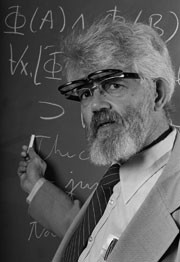Computing Scientist: John McCarthy

Figure 1. John McCarthy
John McCarthy is a renowned computer scientist and mathematician, celebrated as one of the founding figures in the field of artificial intelligence (AI).
He was born in 1927 in Boston, Massachusetts, and passed away in 2011.
John McCarthy was a prodigious individual from a young age. Growing up in a family of scientists near Boston, his early exposure to science laid the foundation for his lifelong scientific interests.
He displayed exceptional intelligence during his formative years, graduating from high school two years ahead of his peers. While attending the California Institute of Technology,
he even skipped the first two years of mathematics courses. However, he encountered challenges in his physical education classes (Shubham, 2018).
Abstraction is one of the central pillars of computational thinking. As Kramer (2007) highlights,
for the construction of models, design, and implementation for specific purposes, abstract thinking is indispensable.
In programming, abstraction simplifies complex problems. By abstracting page elements into HTML tags and styling into CSS rules,
this skill enables clearer organization of information,making it easier to comprehend and maintain.
It will serve as the foundation for future learning in other computer courses.
In terms of his education and career, in 1948, McCarthy earned a Bachelor's degree in mathematics from the California Institute of Technology, and in 1951, he received a Ph.D. in mathematics from Princeton University.
He held teaching positions at Princeton University and Dartmouth College. From 1958 to 1962, he worked on some of the earliest time-sharing systems at the Massachusetts Institute of Technology. During his tenure at Stanford University,
he founded the Stanford Artificial Intelligence Laboratory (Britannica, 2023, p. 2). To this day, John McCarthy's photo remains visible on the homepage of the SAIL official website.
John McCarthy made significant contributions to the field of computer science. His invention of the Lisp programming language, known for its powerful symbol processing and recursive features,
has made it an ideal tool for AI research and is still widely used. McCarthy's introduction of the concept of artificial intelligence (AI) inspired further exploration in AI, and we can see the extensive applications of AI in our work,
education, and daily life, such as smart homes, AI-powered computer assistants, and AI-driven services like AI hotels. His work on time-sharing systems laid the foundation for multi-user computer operations, and the AI laboratory he established provided a robust platform for AI research.
McCarthy's destiny was intertwined with computer science. His exploration in this field can be likened to humanity's exploration of the universe. He proposed to his friends that they should collaborate in building theorem provers,
as they would use symbolic expressions to reason about the world's knowledge (McCorduck, P. 1979).
Refrences
Editors of Encyclopaedia Britannica. (2023, October 20). John McCarthy. Encyclopedia Britannica. [https://www.britannica.com/biography/John-McCarthy]
Lifschitz, V. (2011). Title of the Image [Image]. Nature.
https://media.springernature.com/relative-r300-703_m1050/springer-static/image/art%3A10.1038%2F480040a/MediaObjects/41586_2011_BF480040a_Figa_HTML.jpg?as=webp
McCorduck, P. (1979). Machines Who Think: A Personal Inquiry into the History and Prospects of Artificial Intelligence.
Shubham, A. (2018). 10 Things You Might Not Know about the Father of AI, John McCarthy. Techpp. https://techpp.com